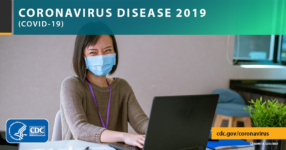
One Health Toolkit for Health Officials Managing Animals with SARS-CoV-2
When an animal tests positive for SARS-CoV-2, a discussion regarding care should occur between the STLT health official(s) and the treating veterinarian. In most instances, animals with SARS-CoV-2 infection are asymptomatic or have mild, self-limiting illness. If the animal is healthy or has mild illness, it can undergo isolation at home or in its respective housing facility.
Considerations in this determination of care should include:
- Severity and complexity of illness in the animal
- Animal welfare
- Risk of severe illness in the owner or caretaker, such as animals owned by or cared for by older adults or those with serious underlying medical conditions
- COVID-19 vaccination status of the owner or caretaker, veterinarian, and staff
- Availability and ability of the veterinarian and their staff to safely provide in-patient care and treatment for the animal
- In companion animals:
- Whether the veterinarian can provide telemedicine consultation so the animal can be examined and treated remotely;
- Where telemedicine and in-patient care are not possible, whether it is safe for the veterinarian to provide in-home care services; and
- Emotional wellbeing and mental health of the companion animal’s owners.
Epidemiologic Investigation of SARS-CoV-2 Test-Positive Animals
The risk of animals spreading SARS-CoV-2 to people is low. However, understanding the epidemiologic context of a positive animal, including human-animal interactions, is important to furthering our understanding of how this virus may circulate and spread under natural conditions. This understanding is necessary to inform public health and animal health measures.
When an animal tests positive for SARS-CoV-2, an epidemiologic investigation should be conducted. Ideally, epidemiologic investigations should be jointly conducted by all relevant STLT and federal One Health partners. Investigation should begin when the case is identified (e.g., an animal is suspected of SARS-CoV-2 infection or tests positive for SARS-CoV-2) – do not wait for presumptive or confirmatory test results.
The investigation should include:
- Description of the diagnostic and clinical factors used to make the case determination;
- Assessment of risk factors in the test-positive animal, including potential source of infection;
- Evaluation of potentially exposed people; and
- Evaluation of potentially exposed animals.
CDC’s One Health Case Investigation Form for Animals with SARS-CoV-2 is a standardized data collection tool for animal investigations that can be completed through HHSProtect. Please contact CDC’s One Health Office for additional guidance and resources on conducting an epidemiologic investigation.
There are no additional precautions recommended for people or animals with potential contact with test-positive animals, aside from animal caretakers. Identifying potential contacts (human or animal) and documenting their health status could help inform the public health risk of these zoonotic SARS-CoV-2 events. Should the risk associated with test-positive animal contacts change, additional precautions may be indicated.
When a SARS-CoV-2 Test-Positive Animal Requires Hospitalization or Veterinary Care
Animals that test positive for SARS-CoV-2 and require veterinary treatment or hospitalization may fall into one of several categories:
- Receiving routine medical care (e.g., vaccinations or boosters)
- Receiving medical care due to pre-existing conditions (e.g., ongoing chemotherapy treatment, monitoring for control of diabetes, worsening of an existing condition)
- Obtaining care for physical injuries and other health conditions unrelated to SARS-CoV-2 (e.g., abscesses, lacerations, fractures)
- Receiving medical care believed to be associated with SARS-CoV-2 infection.
For each category, an evaluation of risk to the veterinary staff should be balanced with medical necessity to make determinations for treatment plans. When safe to do so, non-urgent care should be postponed until the animal is cleared to return to normal activity. Because the risk of animals spreading SARS-CoV-2 to people is low, necessary veterinary care for animals that test positive for SARS-CoV-2 should not be withheld. Rather, biosecurity measures should be enforced, and appropriate PPE [PDF – 2 pages] should be used when administering care.
In the event a sick, SARS-CoV-2 test-positive animal requires transport to a veterinary facility for medical care, follow best practices as outlined below.
For companion animal transport:
- Under ideal conditions, the animal’s owner or caretaker should transport the animal in a private vehicle to the veterinary facility.
- Owners or caretakers with suspected or confirmed COVID-19 should not transport the animal to a veterinary facility. If an owner or caretaker has COVID-19 or is otherwise unable to transport the animal to the veterinary facility in a private vehicle, they should:
- Arrange for a friend or family member from outside the animal’s household to bring the animal to the veterinary facility.
- Transport the animal for curbside pickup if available, while wearing a mask. The caretaker should not enter the premises. A healthy family member can also transport the animal while wearing a mask.
For animal groups other than companion animals that require transport:
- Animal handlers should be trained and prepared to implement biosafety procedures for infectious diseases when transporting animals. These should include infection prevention measures and use of appropriate PPE.
- As few animal handlers as is safe should come into direct contact with the animal.
- Animals should be placed in a secure carrier. Where possible, animals should be transported in species-appropriate, single-use cardboard carriers or hard-shelled animal carriers that can be cleaned and disinfected with an EPA-registered disinfectant after transport.
- Ensure cleaning and disinfection guidelines are followed, and that workers performing these duties are protected from chemical hazards.
- Only the animal and necessary equipment should be transported.
- Animal transport should occur in a vehicle that has an area that can be covered and cleaned and disinfected and is closed off from driver when possible.
There is no evidence that SARS-CoV-2 can spread to people from the skin, fur, or hair of pets. Therefore, additional measures to disinfect the animal, such as bathing, are not necessary.



